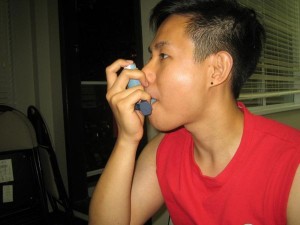Ramon has a long history of asthma, dating back from his early childhood. At his current

age of 75, he still gets asthma attacks. However, one of his worse attacks dates back to when he was in his early 60’s. He was at the cemetery and just buried his mother with his family and other relatives when he suddenly felt shortness of breath and tightening in the chest. Sweat started to trickle down his forehead and he disregarding it as just due to extreme emotional stress. He was still mourning the loss of his mother. Wheezing sounds started every time he exhaled. Soon afterward, Ramon fell in the grass and temporarily lost consciousness. Fortunately, one of his nephews was a doctor and immediate treatment was given. Before long, Ramon was okay again.
When the muscles of air passages go into spasm and linings of the airways swell, asthma attack occurs. This results to the narrowing of the airways and making breathing difficult. There are different factors that trigger asthma attacks such as allergies, cold, extreme temperatures, cigarette smoke, exercise and even stress.
Luckily, for Ramon, a doctor was present. However, not every situation is as fortunate. If the person has an individualized asthma action plan, follow this. Seek for medical assistance for acute asthma attack. However, if the person does not, first aid should be given to an asthma attack patient. The person should sit upright but comfortably. Make loose any tight clothing. If asthma medication is available, assist the person in using it. Find one immediately if the person does not have an inhaler.
If possible, use an inhaler with a spacer. Remove the cap and shake the inhaler well. Tuck in the inhaler into the spacer. Have the person exhale completely and position the mouth around the spacer mouthpiece tightly. To give off a puff, press the inhaler once. Have the person slowly inhale through the mouth and to hold the breath for about 10 seconds. Wait a minute between each puff. Give a total of four puffs.
If absolutely essential, use the inhaler without a spacer. Remove the cap and shake the inhaler well. Tuck in the inhaler into the spacer. While the person inhales slowly, press down on inhaler once. The person should slowly and deeply inhale, approximately five to seven second for each inhale. Wait a minute between each puff. Give a total of four puffs.
If trouble breathing persists after four minutes, give another set of four puffs. If there is little or no improvement, continue giving another set of four puffs every four minutes. Continue doing so until emergency personnel arrives. If the person is suffering from a severe attack, give six to eight puffs every five minutes. Monitor person until help arrives.
Drowsiness may not always mean improvement as it could pertain to a worsening attack. Moreover, disappearance of wheezing sounds cannot be connoted as a sign of improvement. Always seek for medical help after an attack to determine the severity.
The instructions given above do not substitute for first aid training.
